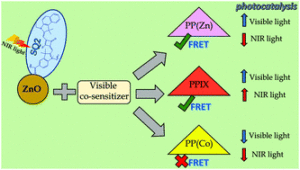J Patwari, A Chatterjee, S Sardar, P Lemmens, SK Pal – Physical Chemistry Chemical …, 2018
Abstract
Co-sensitization to achieve a broad absorption window is a widely accepted technique in light harvesting nanohybrid synthesis. Protoporphyrin (PPIX) and squaraine (SQ2) are two organic sensitizers absorbing in the visible and NIR wavelength regions of the solar spectrum, respectively. In the present study, we have sensitized zinc oxide (ZnO) nanoparticles using PPIX and SQ2 simultaneously for their potential use in broad-band solar light harvesting in photocatalysis. Förster resonance energy transfer (FRET) from PPIX to SQ2 in close proximity to the ZnO surface has been found to enhance visible light photocatalysis. In order to confirm the effect of intermolecular FRET in photocatalysis, the excited state lifetime of the energy donor dye PPIX has been modulated by inserting d10 (ZnII) and d7 (CoII) metal ions in the central position of the dye (PP(Zn) and PP(Co)). In the case of PP(Co)–SQ2, extensive photo-induced ligand to metal charge transfer counteracts the FRET efficiency while efficient FRET has been observed for the PP(Zn)–SQ2 pair. This observation has been justified by the comparison of the visible light photocatalysis of the respective nanohybrids with several control studies. We have also investigated the NIR photocatalysis of the co-sensitized nanohybrids which reveals that reduced aggregation of SQ2 due to co-sensitization of PPIX increases the NIR photocatalysis. However, core-metalation of PPIX reduces the NIR photocatalytic efficacy, most probably due to excited state charge transfer from SQ2 to the metal centre of PP(Co)/PP(Zn) through the conduction band of the host ZnO nanoparticles.

… M -1 cm -1 as per reported literature. 41 The reflecting mode absorption spectra of the nanohybrids were collected by StellarNet ™ spectrograph in diffuse reflection technique. 2.3. Methods for photocatalysis test: The photocatalytic …





